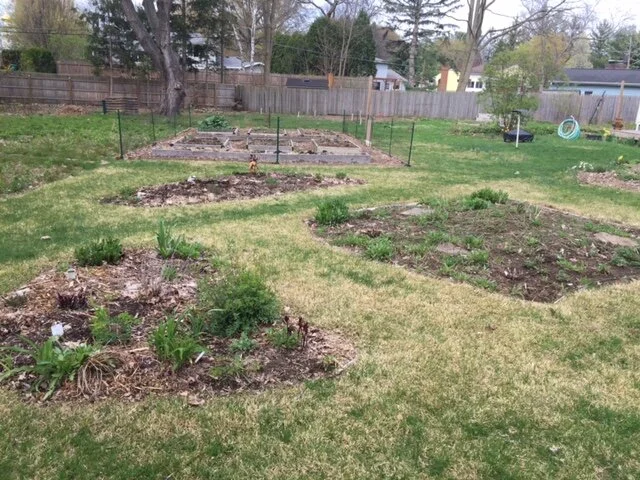Planting Fundamentals: Practical Tips For Placing Perennials
When it comes to planting, proper placement is everything. It doesn't seem like it would be that hard to create something like this enchanting woodland garden I fell in love with on a visit to Chanticleer Gardens in Wayne Pa. (www.chanticleergarden.org), but it actually takes a bit of thought and planning to get this look going. Notice that perennials are massed together in groups and repeated throughout the bed. No bare space.
You might have a bunch of great perennials, but if you don't have enough of them or they're scattered all over the place, they won't show up well and you'll have big bare spaces that invite weeds to the party.
We all want the most amount of beauty from our gardens for the least amount of work don't we?
If you've never done it, the concept of massing plants together might be confusing, so to illustrate how to do it, I'd like to introduce you to someone who allowed me to use her garden as an example. Karen moved from a small city lot to a much larger property in the suburbs and explained, "moving to our current 0.8 acre lot has been absolutely "shell-shocking"!! First off, the lot has 5-6 different planting zones (wet, dry, shady, dappled, full sun in various combinations) as opposed to my previous one or two zones. Secondly, one (or two or even three) plants of any type simply does not work scattered around in the multitude of garden beds we have created. What we would like is a place of limited lawn, lots of perennials (for pollinators and wild life) and minimal care. What we have is a place that requires weeding (until I can't weed anymore), mulching (until the place looks like a lumber yard) or ignoring the whole thing. Much frustration in the face of limited knowledge and no experience with a lot this size."
I sympathize, it does look pretty daunting, and this is only a small part of it.
There are many nice perennials in her gardens, but at first glance, you don't notice them. Why? Because they're scattered about and you don't know where to look. Too much bare space between them allows weeds, causing the maintenance nightmare she refers to.
Here's what we did to get a handle on the situation:
Step 1: I asked her to take make a list of all the perennials she had on hand so we would know exactly what we had to work with. Her first response was, " I did a bit of a plant inventory and no wonder I am overwhelmed!! I have one here and one there of something like 70 plants – and I have bought more just recently. REALLY??!! Tell me I’m not the only person to do this kind of thing." Definitely not, I'd say it's pretty common....after all, we're gardeners!
Step 2:
Her list included coreopsis,salvia,nepeta. liatris, monarda, coneflower and so on. Some were big enough to be divided to make bigger masses. With the list in hand, we walked around to each bed with plant tags and marked out areas for transplants, putting in a label indicating where each one would go.
She began by moving this nepeta (Nepeta faasenii)and some clumps of Scilla campanulata (spring flowering bulbs) from other areas in the garden and grouped them into this bed.
Step 2: After she moved the rest of them to their new homes, we put together a list of low maintenance perennials to add to the bare spots. To match up to the conditions of each of her zones, we referred to Roy Dibliks book, The Know Maintenance Perennial Garden, Timber Press for plant recommendations, (see my previous post (Sustainable and Satisfying 8/27/2016 for more information about Roy's planting philosophy and techniques.)
It's a little early to appreciate the results, but her garden is starting to shape up and I'm looking forward to seeing its progress. You can follow along on this project here later in summer... meanwhile, here is a little more 'how to information' to get going
What defines a mass of plants? Depending on the size of your garden, group the same varieties of perennials in groups of 3, 5, 7 and so on. Repeat them at intervals.The larger your garden is, the bigger masses should be, especially if you're viewing it from a distance. It's kind of like composing a painting, only with plants.
Why is massing plants desirable?
Provides cohesive look to the garden
Allows you to create color schemes, textural and contrasting effects.
Less maintenance - close planting reduces weeding. Putting plants together with similar needs makes quicker work of chores like deadheading, staking etc.
Plants perform better when they are in communities (see Margaret Roach's Q&A interview with Thomas Rainer, What Makes Plants Happy awaytogarden.com)
How and what to plant?
Plant in large blocks - at least 5 or more of one variety.
Vary them - they shouldn’t be the same or the garden will look flat and static.
Use plants with bold foliage and contrast them against something of complimentary color or shape.
Repeat color in different forms.
Use plants to punctuate space.
Use plants of large enough scale to make a statement.
Use one of two plants to emphasize an area.
I rest my case. In my garden, I belong to the "if some is good more is better" school of thought. Why not invite those lonely looking plants floating around in a sea of mulch to join the party?
Need a little more help? Sign up for my monthly newsletter to get tips on dividing perennials easily and successfully!








